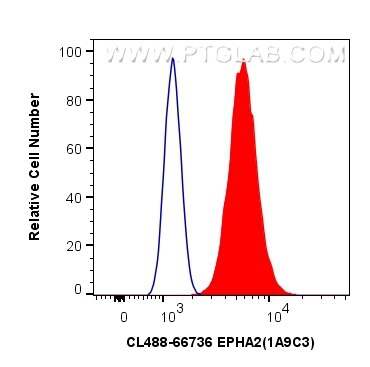- Phare
- Validé par KD/KO
Anticorps Monoclonal anti-EPHA2
EPHA2 Monoclonal Antibody for FC (Intra)
Hôte / Isotype
Mouse / IgG1
Réactivité testée
Humain
Applications
FC (Intra)
Conjugaison
CoraLite® Plus 488 Fluorescent Dye
CloneNo.
1A9C3
N° de cat : CL488-66736
Synonymes
Galerie de données de validation
Applications testées
| Résultats positifs en cytométrie | cellules A431 |
Dilution recommandée
| Application | Dilution |
|---|---|
| Flow Cytometry (FC) | FC : 0.40 ug per 10^6 cells in a 100 µl suspension |
| It is recommended that this reagent should be titrated in each testing system to obtain optimal results. | |
| Sample-dependent, check data in validation data gallery | |
Informations sur le produit
CL488-66736 cible EPHA2 dans les applications de FC (Intra) et montre une réactivité avec des échantillons Humain
| Réactivité | Humain |
| Hôte / Isotype | Mouse / IgG1 |
| Clonalité | Monoclonal |
| Type | Anticorps |
| Immunogène | EPHA2 Protéine recombinante Ag22566 |
| Nom complet | EPH receptor A2 |
| Masse moléculaire calculée | 976 aa, 108 kDa |
| Poids moléculaire observé | 130 kDa |
| Numéro d’acquisition GenBank | BC037166 |
| Symbole du gène | EPHA2 |
| Identification du gène (NCBI) | 1969 |
| Conjugaison | CoraLite® Plus 488 Fluorescent Dye |
| Excitation/Emission maxima wavelengths | 493 nm / 522 nm |
| Forme | Liquide |
| Méthode de purification | Purification par protéine G |
| Tampon de stockage | PBS avec glycérol à 50 %, Proclin300 à 0,05 % et BSA à 0,5 %, pH 7,3. |
| Conditions de stockage | Stocker à -20 °C. Éviter toute exposition à la lumière. Stable pendant un an après l'expédition. L'aliquotage n'est pas nécessaire pour le stockage à -20oC Les 20ul contiennent 0,1% de BSA. |
Informations générales
Ephrin type-A receptor 2 (EPHA2), belongs to the receptor tyrosine kinases (RTKs) family, that binds promiscuously membrane-bound ephrin-A family ligands residing on adjacent cells, leading to contact-dependent bidirectional signaling into neighboring cells. Research studies have shown that Eph receptors and ligands may be involved in many diseases including cancer (PMID: 11114742). The "reverse signaling" function, whereby the cytoplasmic domain becomes tyrosine phosphorylated, allows interactions with other proteins that may activate signaling pathways in the ligand-expressing cells.
Protocole
| Product Specific Protocols | |
|---|---|
| FC protocol for CL Plus 488 EPHA2 antibody CL488-66736 | Download protocol |
| Standard Protocols | |
|---|---|
| Click here to view our Standard Protocols |


